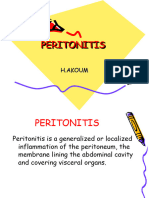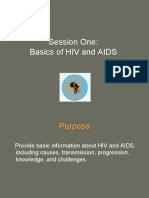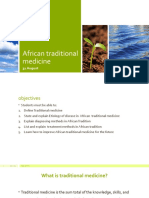0 ratings0% found this document useful (0 votes)
18 viewsPancreatitis
Pancreatitis
Uploaded by
Ibrahim kargboAcute pancreatitis is inflammation of the pancreas that ranges from mild to severe. The most common causes are gallstones and alcohol use. The pancreas digests itself due to activation of enzymes within the pancreas rather than the intestine. Symptoms include severe abdominal pain, nausea, and vomiting. Complications can include pseudocysts, abscesses, and lung or heart issues. Diagnostic tests include blood tests and imaging scans of the pancreas. Treatment focuses on pain relief, fluid resuscitation, reducing secretions, and addressing underlying causes or complications.
Copyright:
© All Rights Reserved
Available Formats
Download as PPTX, PDF, TXT or read online from Scribd
Pancreatitis
Pancreatitis
Uploaded by
Ibrahim kargbo0 ratings0% found this document useful (0 votes)
18 views13 pagesAcute pancreatitis is inflammation of the pancreas that ranges from mild to severe. The most common causes are gallstones and alcohol use. The pancreas digests itself due to activation of enzymes within the pancreas rather than the intestine. Symptoms include severe abdominal pain, nausea, and vomiting. Complications can include pseudocysts, abscesses, and lung or heart issues. Diagnostic tests include blood tests and imaging scans of the pancreas. Treatment focuses on pain relief, fluid resuscitation, reducing secretions, and addressing underlying causes or complications.
Copyright
© © All Rights Reserved
Available Formats
PPTX, PDF, TXT or read online from Scribd
Share this document
Did you find this document useful?
Is this content inappropriate?
Acute pancreatitis is inflammation of the pancreas that ranges from mild to severe. The most common causes are gallstones and alcohol use. The pancreas digests itself due to activation of enzymes within the pancreas rather than the intestine. Symptoms include severe abdominal pain, nausea, and vomiting. Complications can include pseudocysts, abscesses, and lung or heart issues. Diagnostic tests include blood tests and imaging scans of the pancreas. Treatment focuses on pain relief, fluid resuscitation, reducing secretions, and addressing underlying causes or complications.
Copyright:
© All Rights Reserved
Available Formats
Download as PPTX, PDF, TXT or read online from Scribd
Download as pptx, pdf, or txt
0 ratings0% found this document useful (0 votes)
18 views13 pagesPancreatitis
Pancreatitis
Uploaded by
Ibrahim kargboAcute pancreatitis is inflammation of the pancreas that ranges from mild to severe. The most common causes are gallstones and alcohol use. The pancreas digests itself due to activation of enzymes within the pancreas rather than the intestine. Symptoms include severe abdominal pain, nausea, and vomiting. Complications can include pseudocysts, abscesses, and lung or heart issues. Diagnostic tests include blood tests and imaging scans of the pancreas. Treatment focuses on pain relief, fluid resuscitation, reducing secretions, and addressing underlying causes or complications.
Copyright:
© All Rights Reserved
Available Formats
Download as PPTX, PDF, TXT or read online from Scribd
Download as pptx, pdf, or txt
You are on page 1of 13
PANCREATITIS
Acute and Chronic
Definition
• Acute pancreatitis is an acute inflammation of
the pancreas.
• The degree of inflammation varies from mild
edema to severe
Etiology of Acute Pnacreatitis
• Many factors can cause injury to the pancreas.
• most common cause is gallbladder disease (gallstones), which is more
common in women.
• The second most common cause is chronic alcohol intake, which is
more common in men.
• Smoking is an independent risk factor for acute pancreatitis.
Pathophysiology of Acute Pancreatitis
• The most common pathogenic mechanism is autodigestion of the pancreas.
• The etiologic factors injure pancreatic cells or activate the pancreatic
enzymes in the pancreas rather than in the intestine. This may be due to
reflux of bile acids into the pancreatic ducts through an open or distended
sphincter of Oddi.
• This reflux may be caused by blockage created by gallstones.
• Obstruction of pancreatic ducts results in pancreatic ischemia.
• The exact mechanism by which chronic alcohol intake predisposes a person
to pancreatitis is not known.
• It is thought that alcohol increases the production of the digestive enzymes
in the pancreas.
Clinical Manifestations
• Abdominal pain is the predominant manifestation of acute pancreatitis.
• The pain is due to distention of the pancreas, peritoneal irritation, and obstruction of the
biliary tract.
• LUQ pain, but it may be in the mid-epigastrium may radiate to the back because of the
retroperitoneal location of the pancreas.
• Pain has a sudden onset, is severe, deep, piercing, continuous or steady.
• The pain is aggravated by eating and frequently has its onset when the patient is recumbent.
• It is not relieved by vomiting.
• Pain may be accompanied by flushing, cyanosis, and dyspnea.
• nausea and vomiting, low-grade fever, leukocytosis, hypotension, tachycardia, and jaundice
Clinical Manifestations
• Abdominal tenderness with muscle guarding is common.
• Bowel sounds may be decreased or absent.
• Paralytic ileus may occur and causes marked abdominal distention.
• The lungs are frequently involved, with crackles present.
• Intravascular damage from circulating trypsin may cause areas of cyanosis or greenish
to yellow-brown discoloration of the abdominal wall.
• Other areas of ecchymoses are the flanks (Grey Turner’s spots or sign,
• a bluish flank discoloration) and the periumbilical area (Cullen’s
• sign, a bluish periumbilical discoloration).
• These result from seepage of blood-stained exudate from the pancreas and may occur
in severe cases.
Complications
• Some patients recover completely, others have recurring attacks, and
others develop chronic pancreatitis.
• complications of acute pancreatitis are pseudocyst and abscess.
• systemic complications of acute pancreatitis are pulmonary (pleural
effusion, atelectasis, pneumonia, and acute respiratory distress
syndrome [ARDS]) and cardiovascular (hypotension) complications
and tetany caused by hypocalcemia.
Diagnostic Studies
• The primary diagnostic tests for acute pancreatitis are serum amylase
and lipase
• Other findings include an increase in liver enzymes, triglycerides,
glucose, and bilirubin and a decrease in calcium.
• An abdominal ultrasound, x-ray, or contrast-enhanced CT scan can be
used to identify pancreatic problems.
Collaborative Care
Goals of collaborative care for acute pancreatitis include
• (1) relief of pain;
• (2) prevention or alleviation of shock;
• (3) reduction of pancreatic secretions;
• (4) correction of fluid and electrolyte imbalances;
• (5) prevention or treatment of infections; and
• (6) removal of the precipitating cause, if possible
Collaborative Care
• First, the patient is NPO (taking nothing by mouth).
• Second, NG suction may be used to reduce vomiting and gastric
distention and to prevent gastric acidic contents from entering the
duodenum.
• In addition, certain drugs may be used to suppress gastric acid
secretion
NURSING MANAGEMENT
ACUTE PANCREATITIS
NURSING DIAGNOSES
Nursing diagnoses for the patient with acute pancreatitis may
• include, but are not limited to, the following:
• Acute pain related to distention of pancreas, peritoneal irritation,
obstruction of biliary tract, and ineffective pain and comfort measures
• Deficient fluid volume related to nausea, vomiting, restricted oral
intake, and fluid shift into the retroperitoneal space
• Imbalanced nutrition: less than body requirements related to
anorexia, dietary restrictions, nausea, loss of nutrients from vomiting,
and impaired digestion
You might also like
- 2020-2021 Benefit Rates - CVS HealthDocument9 pages2020-2021 Benefit Rates - CVS HealthNand Patel100% (1)
- Blood Pressure SolutionDocument68 pagesBlood Pressure Solutionmgrfan100% (14)
- Treating The Divergent MeridiansDocument6 pagesTreating The Divergent MeridiansMichalina Marta Marciniak100% (2)
- Case Concept Acute PrancreatitisDocument8 pagesCase Concept Acute PrancreatitisGio GallegoNo ratings yet
- By DR.: Haitham Mokhtar Mohamed Abd AllahDocument101 pagesBy DR.: Haitham Mokhtar Mohamed Abd AllahMohamed ElkadyNo ratings yet
- Askep PankreatitisDocument48 pagesAskep PankreatitisYeni DwiNo ratings yet
- Pancreatitis: Def Pancreatitis (Inflammation of The Pancreas) Is A Serious Disorder. The Most Basic Classification SystemDocument5 pagesPancreatitis: Def Pancreatitis (Inflammation of The Pancreas) Is A Serious Disorder. The Most Basic Classification SystemSanthu Su100% (2)
- Intestinal Obstruction: by Dr. Shereen Abd El-MoniemDocument44 pagesIntestinal Obstruction: by Dr. Shereen Abd El-MoniemフセインNo ratings yet
- Acute PancreatitisDocument35 pagesAcute PancreatitisJerson Ingno100% (5)
- Acute PancreatitisDocument43 pagesAcute Pancreatitisassefa.abdissaNo ratings yet
- Disorders of Biliary SystemDocument29 pagesDisorders of Biliary SystemAjibola OlamideNo ratings yet
- PANCREASDocument74 pagesPANCREASzaiba0786No ratings yet
- Acute PancreatitisDocument7 pagesAcute PancreatitisVytheeshwaran Vedagiri100% (9)
- Acute Pancreatitis ENCC 1Document30 pagesAcute Pancreatitis ENCC 1adugna cherkosNo ratings yet
- Acute Pancreatitis SymptomsDocument12 pagesAcute Pancreatitis SymptomsUthraa SalvatoreNo ratings yet
- GI Stressors II StudentDocument67 pagesGI Stressors II StudentBiji Thomas GeorgeNo ratings yet
- Acute AbdomenDocument24 pagesAcute AbdomenGrace SimmonsNo ratings yet
- Chronic PancreatitisDocument48 pagesChronic Pancreatitismolinbenisto100No ratings yet
- Case 5 - Pancreatitis-1Document4 pagesCase 5 - Pancreatitis-1ngNo ratings yet
- Approach of A Patient With JaundiceDocument41 pagesApproach of A Patient With JaundiceDr. 001No ratings yet
- Chronic PancreatitisDocument41 pagesChronic PancreatitisLloyd ChrisNo ratings yet
- 1 Gallbladder Disease 2Document68 pages1 Gallbladder Disease 2salsabeelNo ratings yet
- Week3 PancreasDocument74 pagesWeek3 PancreasriverabeanicoNo ratings yet
- Nu'man AS DaudDocument23 pagesNu'man AS DaudHidayat BazeherNo ratings yet
- Acute CholecystitisDocument12 pagesAcute CholecystitisDwi AstutyNo ratings yet
- Dyspepsia GastritisDocument80 pagesDyspepsia GastritisSoumya Ranjan PandaNo ratings yet
- Other Problems in Inflammatory ResponseDocument62 pagesOther Problems in Inflammatory ResponseJR Rolf NeuqeletNo ratings yet
- Obstructive JaundiceDocument35 pagesObstructive JaundiceHooney SinghNo ratings yet
- Session 20-Gastritis and PudDocument42 pagesSession 20-Gastritis and Pudgbunyara100No ratings yet
- Acute AbdomenDocument53 pagesAcute AbdomenMahdi DiabNo ratings yet
- Gastro Week 5: Gilbert S. 2014Document43 pagesGastro Week 5: Gilbert S. 2014LioraNo ratings yet
- Assessment and Management of Patients With Biliary DisorderDocument50 pagesAssessment and Management of Patients With Biliary DisorderZanida ZainonNo ratings yet
- PancreatitisDocument45 pagesPancreatitisabdullaahi449No ratings yet
- Gastro Intestinal DisordersDocument35 pagesGastro Intestinal Disordersmaryam ruunNo ratings yet
- Gastric and Duodenal DisordersDocument12 pagesGastric and Duodenal DisordersSandeep100% (1)
- Peptic Ulcer Nursing CareDocument5 pagesPeptic Ulcer Nursing CareFuad TalNo ratings yet
- Acute Cholecystitis: Mentor: Dr. Amran Sinaga, SP.BDocument18 pagesAcute Cholecystitis: Mentor: Dr. Amran Sinaga, SP.Bevita oktaviaNo ratings yet
- Acute AbdomenDocument56 pagesAcute AbdomenponekNo ratings yet
- Biliary&Pancreas DisordersDocument34 pagesBiliary&Pancreas DisordersLarry De LaraNo ratings yet
- Acutep 1Document45 pagesAcutep 1api-19916399No ratings yet
- First Problem: Erwin Budi/405130151Document42 pagesFirst Problem: Erwin Budi/405130151Rilianda SimbolonNo ratings yet
- Acute PancreatitisDocument40 pagesAcute PancreatitisMustafa HusainNo ratings yet
- GIT 2021 Lect17Document49 pagesGIT 2021 Lect17Nikkole PhalulaNo ratings yet
- Pancreatitis: What Is The Pancreas and What Does It Do?Document5 pagesPancreatitis: What Is The Pancreas and What Does It Do?NonameNo ratings yet
- StomachDocument86 pagesStomachSuneel Kaushik KNo ratings yet
- Pancreatitis PDFDocument19 pagesPancreatitis PDFSidraNo ratings yet
- PANCREATITISDocument6 pagesPANCREATITISAmik, Aila H.No ratings yet
- Gastrointestinal Bleeding: Dr. Isbandiyah, SPPD FK UmmDocument25 pagesGastrointestinal Bleeding: Dr. Isbandiyah, SPPD FK Ummikaummu amaliahNo ratings yet
- MalabsorptionDocument83 pagesMalabsorptionmasreshaNo ratings yet
- Student Copy of Gastrointestinal Problems SP 2010 IggyDocument80 pagesStudent Copy of Gastrointestinal Problems SP 2010 IggyJade CentinoNo ratings yet
- Chronic Pancreatitis 2222Document45 pagesChronic Pancreatitis 2222Mihraban OmerNo ratings yet
- CHOLECYSTITISDocument14 pagesCHOLECYSTITISAlkiana SalardaNo ratings yet
- Pancreatitis: 1 Signs and SymptomsDocument6 pagesPancreatitis: 1 Signs and SymptomsZiedTrikiNo ratings yet
- CHOLELITHIASISDocument12 pagesCHOLELITHIASISShenbagam MahalingamNo ratings yet
- Cholelithiasis, Choledocholithiasis, PancreatitisDocument47 pagesCholelithiasis, Choledocholithiasis, PancreatitisGreysia ManarisipNo ratings yet
- Cancer StomachDocument28 pagesCancer Stomachsameeha semiNo ratings yet
- 1100 Ultrasound of The Acute Abdomen 15 3Document84 pages1100 Ultrasound of The Acute Abdomen 15 3gp1promo2016No ratings yet
- INTESTINEDocument98 pagesINTESTINEDeepika LingamNo ratings yet
- Inflammatory GI Disorders - DR Shazia JamsheedDocument24 pagesInflammatory GI Disorders - DR Shazia JamsheedShumaila QadirNo ratings yet
- GS DivisionDocument42 pagesGS DivisionDonald IDEDENo ratings yet
- PERITONITISDocument12 pagesPERITONITISHayat AL AKOUM100% (1)
- GerdDocument43 pagesGerdNidhi shriNo ratings yet
- Definition and Importance: Exercise PhysiologyDocument16 pagesDefinition and Importance: Exercise PhysiologyIbrahim kargboNo ratings yet
- Triage: Prepared by Mr. Migron Rubin M.Sc. Nursing Ist Year Pragyan College of Nursing BhopalDocument13 pagesTriage: Prepared by Mr. Migron Rubin M.Sc. Nursing Ist Year Pragyan College of Nursing BhopalIbrahim kargboNo ratings yet
- Module1 Overview HivinfectionDocument20 pagesModule1 Overview HivinfectionCristine BarrozaNo ratings yet
- Session One: Basics of HIV and AIDSDocument32 pagesSession One: Basics of HIV and AIDSIbrahim kargboNo ratings yet
- New HSE Monthly Report Statistic 2015Document47 pagesNew HSE Monthly Report Statistic 2015IchsanNo ratings yet
- HAT I GREEN (I)Document19 pagesHAT I GREEN (I)Saima ZaibNo ratings yet
- Iv Therapy & BT (Skills)Document90 pagesIv Therapy & BT (Skills)jes_04100% (2)
- Sicp Busy Day Systematic Approach Answering Drug Info RequestsDocument7 pagesSicp Busy Day Systematic Approach Answering Drug Info RequestsNight WarriorNo ratings yet
- Ethnopharmacology and Drug Discovery: Bhushan PatwardhanDocument3 pagesEthnopharmacology and Drug Discovery: Bhushan PatwardhanAle GonzagaNo ratings yet
- Final - Wellness Tourism Strategic Framework 2023 2028Document29 pagesFinal - Wellness Tourism Strategic Framework 2023 2028Joaquin Niccolas TulabutNo ratings yet
- Tempra Dosage ChartDocument1 pageTempra Dosage ChartTintin Brusola SalenNo ratings yet
- RTPS Internal Audit Check ListDocument3 pagesRTPS Internal Audit Check Listpradeep kodlekereNo ratings yet
- A Perfect Storm Examining The Supply Chain For N95 Masks During Covid-19Document12 pagesA Perfect Storm Examining The Supply Chain For N95 Masks During Covid-19Mark RojasNo ratings yet
- NFHS-5 State Factsheet Compendium - Phase-IDocument145 pagesNFHS-5 State Factsheet Compendium - Phase-IMilu CyriacNo ratings yet
- Self-Control Importance and BenefitsDocument4 pagesSelf-Control Importance and BenefitsZainiNo ratings yet
- Vet Assistant Cover LetterDocument5 pagesVet Assistant Cover Letterykzdmfajd100% (2)
- PMAC Project-Brief Digital-VersionDocument4 pagesPMAC Project-Brief Digital-Versionmehta.climbonNo ratings yet
- Psychological Aspects of Living With HIV Disease: PracticeDocument4 pagesPsychological Aspects of Living With HIV Disease: PracticeAntro BerrinNo ratings yet
- Lesson Plan in Community - HealthDocument10 pagesLesson Plan in Community - HealthDaisy Rose ServandilNo ratings yet
- Terence Lenamon's Trial Documents: Examination of Dr. Deborah Mash in State of Florida V Grady Nelson Death Penalty TrialDocument26 pagesTerence Lenamon's Trial Documents: Examination of Dr. Deborah Mash in State of Florida V Grady Nelson Death Penalty TrialReba KennedyNo ratings yet
- Olainfarm Product CatalogueDocument40 pagesOlainfarm Product Catalogueeverstrong0% (1)
- Viral Hepatitis in Pregnancy: DR Eleni Nastouli Consultant in Virology and Paediatric Infectious DiseasesDocument34 pagesViral Hepatitis in Pregnancy: DR Eleni Nastouli Consultant in Virology and Paediatric Infectious Diseasesrilla saeliputriNo ratings yet
- Profil Pasien Ensefalokel Anak Usia 0 - 18 Tahun Di Departemen Bedah Saraf Rsud Dr. Soetomo SurabayaDocument5 pagesProfil Pasien Ensefalokel Anak Usia 0 - 18 Tahun Di Departemen Bedah Saraf Rsud Dr. Soetomo SurabayaReandy Ilham AndriyonoNo ratings yet
- Care PlanDocument1 pageCare PlanFahim AhmedNo ratings yet
- IntroductionDocument13 pagesIntroductionSaadNo ratings yet
- Task Risk Assessment (TRA) : Project Name: Area On Site: Task Description: BTD InstallationDocument6 pagesTask Risk Assessment (TRA) : Project Name: Area On Site: Task Description: BTD InstallationADEEL SHAHZADNo ratings yet
- NCP StrokeDocument2 pagesNCP StrokeMichael John F. NatividadNo ratings yet
- Ielts EssayDocument54 pagesIelts EssayHeyder Hiko HesenovNo ratings yet
- Presentation - Medical Park Hospitals - 041218203142Document34 pagesPresentation - Medical Park Hospitals - 041218203142Dalmar Ibrahim OmarNo ratings yet
- African Traditional MedicineDocument14 pagesAfrican Traditional MedicineStarnley Tembo100% (1)
- MLM Module 3 - Immunization SafetyDocument41 pagesMLM Module 3 - Immunization Safetyhrhpalimbang2024No ratings yet





























































































